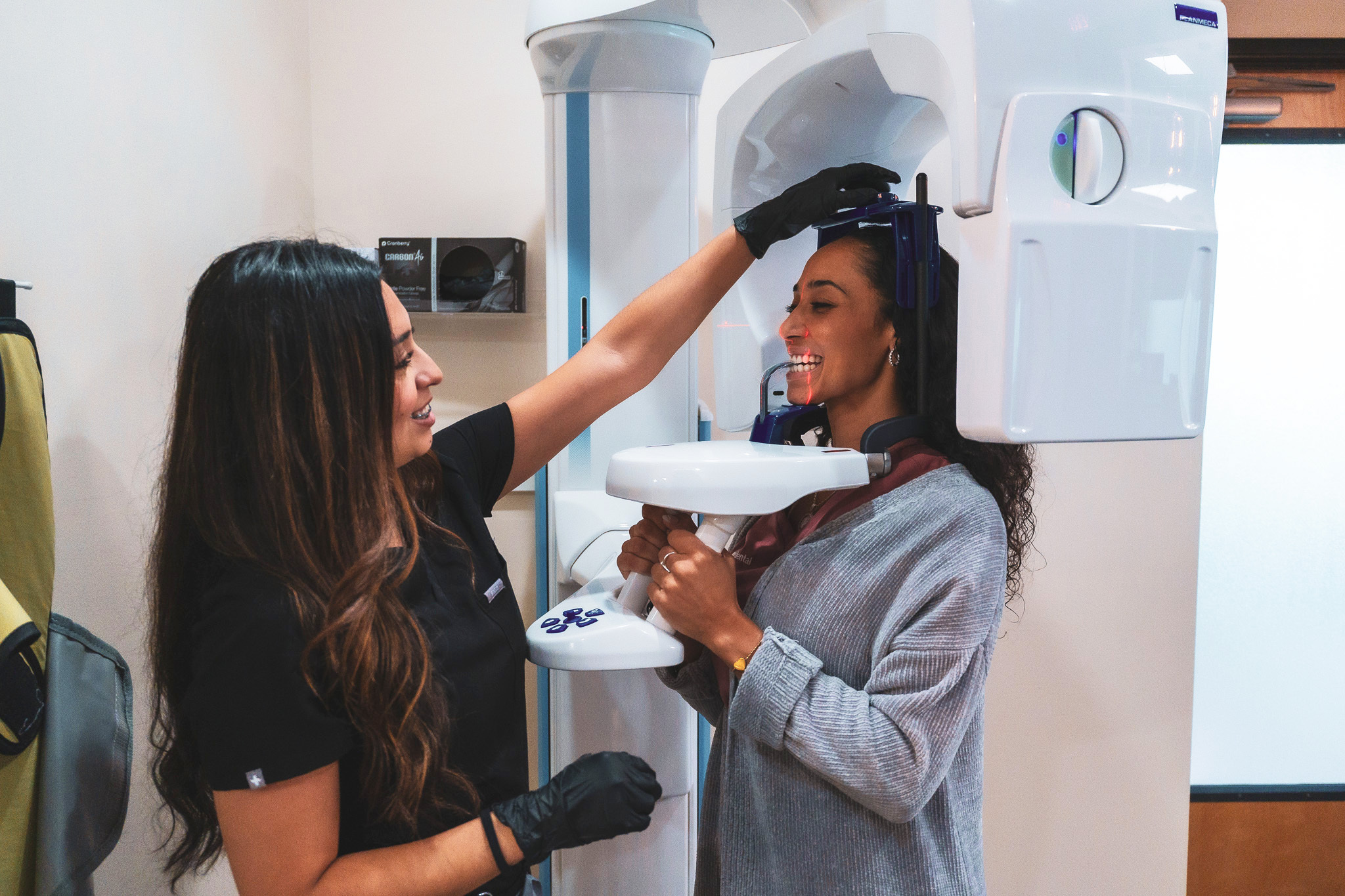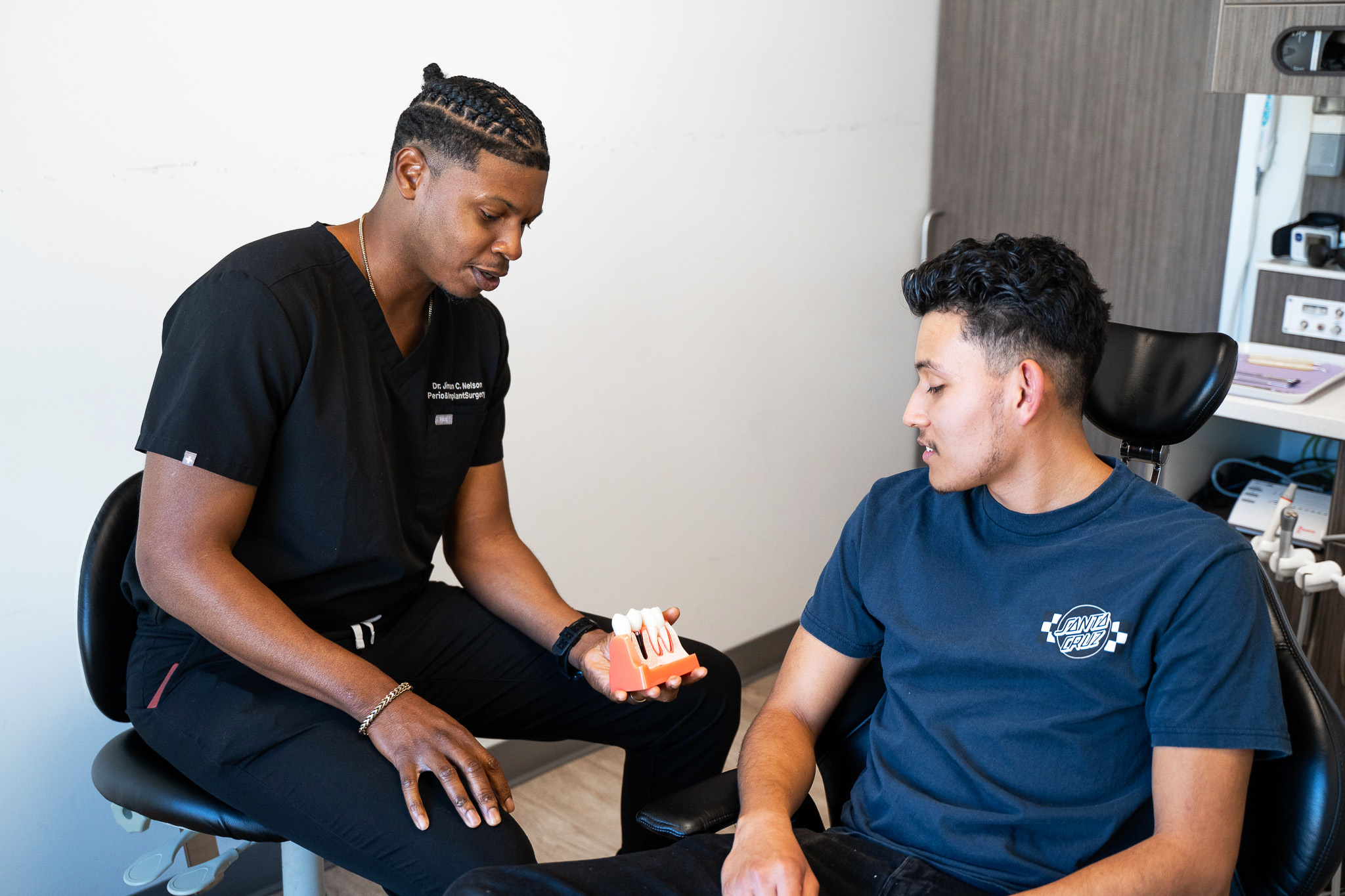Your incisors are the teeth at the front of your mouth. You have eight incisors in total: four on the top and bottom rows of teeth. These are the first teeth people see when you talk or smile, and they’re crucial for your oral health, ability to communicate, and appearance.
![]()
Your permanent central and lateral incisors typically arrive between seven and nine and perform critical functions. If you lose one of these teeth, you can continue to perform those functions and enjoy the benefits of strong front teeth if you replace the gap with a dental implant.
One of the primary functions of your front teeth is cutting food. You need your front teeth to bite into your food and break it into small pieces until it’s safe to swallow. You have a higher risk of choking if you can’t break food down into smaller pieces. You can maintain your ability to chew food with dental implants if you’ve lost one or more of your front teeth.
Your front teeth support your cheeks and lips. Your facial muscles will sag without them. Sagging facial muscles affect the structure of your face and make you appear older than you are. Replacing a lost front tooth with dental implants ensures you maintain your facial structure and look your best.
Suppose you have damaged front teeth. The teeth are still in place, but they’re discolored. You could improve the appearance of your tooth with porcelain veneers. Porcelain veneers are more affordable than dental implants, which may tempt you to opt for porcelain veneers to improve your smile’s appearance.
Although veneers cost less than implants, dental implants can last for decades because they are stronger than porcelain veneers, while veneers have a shorter lifespan. Veneers do help strengthen your teeth, but they can crack. Implants are more durable and typically save you money. They also reduce the frequency of dental treatments while enabling you to use your front teeth normally.
Many people realize that oral health issues, like periodontitis and cavities, can cause tooth loss. However, tooth loss can also cause oral health issues. When you invest in a dental implant to replace a missing tooth, you’re choosing an appliance that can prevent bone loss. Preventing bone loss helps you avoid needing bone grafting to treat bone loss. Implants also decrease the risk of recurring gum disease.
Since you need your front teeth to break down food, your front teeth significantly impact your overall health. You may have difficulty getting the nutrients you need if you’re unable to break down foods.
You use your teeth, mouth muscles, lips, jaw, and tongue to form sounds when you speak. Your ability to construct sounds is compromised if you have gaps from missing teeth. Implants ensure your speech isn’t affected by tooth loss.
The front teeth are essential for aesthetic value and functionality. You need your front teeth to maintain a beautiful smile, retain optimal bite force, and much more. If you’ve lost your front tooth because of injuries, accidents, or dental decay, you need to consider your front tooth replacement options. You have several options when it comes to front tooth replacement, including a dental bridge for the front tooth, partial dentures for the front teeth, and a dental implant for the front tooth. We will discuss the unique features of all your front tooth replacement options in Houston.

A dental bridge is ideal for patients who want to replace one or two connected front teeth. A dental bridge is a series of fake teeth, known as pontics, supported by dental crowns on both sides. If you’re missing a front tooth, you can get a dental bridge consisting of one pontic and two dental crowns. The dentist will shave off some of the structure from the surrounding teeth to accommodate the dental crowns, which will hold the pontic in the location of the missing tooth. A dental bridge is a stable replacement for a missing tooth but doesn’t support the underlying jawbone. Furthermore, to receive a dental bridge, the surrounding healthy teeth have to be filed down into small stubs.
A partial denture is a removable dental appliance with a fake tooth in the location of the missing tooth. The denture is supported on a gum-colored base attached to the back of your teeth with metallic clasps. The artificial tooth is strategically positioned to take the place of the missing front tooth. Partial dentures are removable, and you need to take them off a few times a day to clean and maintain them. Furthermore, partial dentures can also slip or slide out of place, so they don’t offer the same visual appeal and stability as natural teeth. You can get partial dentures for temporary front tooth replacement, but they’re not suitable for long-term teeth replacement.
A front tooth implant is the best tooth replacement option for the front teeth. A tooth implant is a titanium screw that’s drilled into the jawbone underneath the socket of the missing tooth. Once the titanium implant is placed, it triggers the osseointegration process whereby your jawbone tissues naturally merge with the titanium implant surface, becoming an essential and integrated component of your dental anatomy. Over time, the front tooth implant replaces the missing tooth’s root structure, offering a firm and stable base for tooth restoration. Dental implants are indistinguishable from natural teeth in form and functionality, so a dental implant for the front tooth is ideal. If you’re missing one front tooth, you can get one titanium dental implant to support a dental crown.
Dental implants are superior to other tooth replacement options for one primary reason — dental implants replace the root structures of the missing teeth. In contrast, all other teeth replacement options only address the visible components. Dental bridges and dentures might provide the external appearance of teeth, but they don’t support the underlying jawbone tissues or restore complete bite force. A front tooth implant is an integrated part of the dental anatomy because it replaces the root structure. As such, dental implants restore complete bite force, and they allow you to eat whatever you want. Dental implants also support your natural jawbone tissues and prevent jawbone resorption by the body.

Yes. You can definitely implant front teeth. In fact, since the front teeth are the most visible, there is great value in placing dental implants on the front teeth. Since the front teeth are highly visible, people can usually tell if you’re wearing dentures for your front teeth. However, dental implants are firmly rooted parts of your dental anatomy, so they’re indistinguishable from natural teeth.
The steps for installing dental implants can vary. You may require fewer treatments if you’ve already lost a tooth. However, your implant procedure will have extra steps if you need to have a tooth removed.
The process of getting dental implants begins with a consultation. Book an appointment with your dentist to discuss your missing or damaged tooth and identify your options. A dental bridge or dentures are alternatives to dental implants. Your dentist can explain the costs of each procedure and how long each appliance will last. Dental implants deliver all the benefits of natural teeth, making them an ideal option.
Your dentist will take X-rays, perform an examination, and develop a treatment plan for your missing or damaged tooth. Your dentist may also make models or capture 3D images of your teeth and jaw. These models or pictures can be used to construct your implants. You should mention any concerns you have during your consultation and discuss sedation options if you suffer from dental anxiety.
Your dental implant surgeries can involve several steps. You may have several appointments to complete all steps, depending on the nature of the work required to install your implants.
You may stay awake during the procedure and receive local anesthesia to prevent pain, or you may opt for general anesthesia so that you can sleep through the surgery. Before your surgery, you should discuss your options and preferences to ensure your comfort during the procedure.
You may need surgery to remove any damaged bone from your mouth before your implants can be installed. It doesn’t take long to start losing bone mass once you lose a tooth, which is why you may need a bone graft to strengthen your jawbone before the metal post is installed.
Implants are artificial teeth. These artificial teeth are installed in your mouth to replace your missing teeth. They are attached to metal posts implanted in your jawbone. Implanting metal rods is the first step when installing implants. Implanting the rods involves cutting through the gums and drilling holes in your jawbone. The metal post is put in the hole in your jawbone. It extends into the jawbone to serve as a substitute for your missing roots.
Your gums and jawbone need to heal before you can have your permanent implant attached to the metal post.
During the healing process, your jawbone grows. This growth allows it to connect with the metal rod so the rod is anchored in place. It can take months for your jawbone and post to fuse together.
Once your jawbone and metal rod fuse, you will have another treatment to attach the abutment to the metal post. The abutment connects to the metal rod. Placing the abutment involves reopening your gums to join the metal post and abutment. The abutment will protrude from your gum line so the implant can be attached to it at your next appointment.
You may opt for partial dentures, which snap to the abutment and can be removed. You can also opt for permanent implants. Your permanent implant could be a single crown replacing one tooth or a bridge that connects to the abutment and replaces multiple missing teeth.
Your permanent implants cannot be removed once attached to the abutment.
After the front tooth implant is placed, your body will initiate the osseointegration process. Osseointegration is a natural process wherein your jawbone tissues fuse with the titanium implant surface, making it an integrated part of your dental anatomy. The entire osseointegration process takes around six months, depending on your specific healing speed. However, most of the healing process occurs in the background without your conscious awareness. You can proceed with your daily activities and eat whatever you want a few days after the dental implant surgery.
Anesthesia prevents pain during the procedures, but you may feel some discomfort after the anesthesia wears off. You should discuss any concerns you have about the procedure with your dentist when developing your treatment plan. Your dentist can prescribe painkillers after installing the metal post, abutment, and implants.
Symptoms you may experience after the procedures include the following:
It takes between one and two weeks for stitches to dissolve. During this time, you may need to eat soft foods to prevent damage during your recovery. Appropriate soft foods include the following:
The cost of dental implants depends on whether you need a tooth extracted first, how many teeth you’re replacing, whether you have dental insurance, and the terms of coverage from your insurance plan. The typical cost to replace one tooth is almost $5,000.
Depending on your insurance policy, you may have to cover 25 to 50% of the costs. You may have additional costs if you need prescription painkillers after treatments. You should consult your dentist about payment options when developing your treatment plan.
You can find a knowledgeable dental implant dentist at URBN Dental, the leading group of dental clinics specializing in dental implants in Houston. Our dental implant center is led by Dr. Jiman Nelson, an incredibly talented and reputable oral surgeon and dentist specializing in cutting-edge dental implant techniques, such as the all-on-four dental implant procedure. If you’re missing a front tooth, please contact our dental implant dentist in Houston.
URBN Dental is a state-of-the-art dental implant center specializing in the latest and safest dental implant techniques. We provide numerous options for patients seeking to replace front teeth, including dental bridges, dental implants, and dentures. Our Houston dentists help you find the ideal tooth replacement solutions according to your unique needs and goals. We have dental implant centers in Uptown Houston, Midtown Houston, Montrose, and East River. Please schedule an appointment for your dental implant in Houston.

Partial dentures and permanent implants look like real teeth. They help restore the functions of missing teeth and improve your smile’s appearance.
You may not have significant bone loss if you consult your dentist about dental implants as soon as you lose your tooth. However, it’s crucial for your dentist to take X-rays and determine how much bone you’ve lost. You must have a bone graft if you’ve suffered significant bone loss to ensure your jawbone can support the metal posts.
You can’t remove permanent dental implants. You can opt for partial dentures, which are removable.
The lifespan of dental appliances can be affected by life events and your oral health. An implant can be damaged if you suffer facial trauma. Poor oral hygiene can undermine the stability of your implant. Without external factors, such as accident injuries and oral health issues, permanent implants can last for up to three decades. Partial dentures last for up to 15 years.
About Tooth Loss. (2024).
Archibald, J. (2023). Teeth: Name, types, and functions.
Tooth loss in older adults. (2024).
Walrack, J. (2024). How to Get Dental Implants Covered By Insurance.
Watson, S. (2024). Importance of Your Incisor Teeth.
Houston | Katy | Montrose | West University Place | Greater Third Ward | Greater East End | North East Houston | Houston Heights | Central Northwest | Fairbanks | Acres Home | East Houston | Southeast Houston | Central Southwest | Fort Bend Houston | Brays Oaks | Meyerland Area | Sharpstown | Alief | Westchase | Memorial | Northwest Houston | Katyland | Whispering Lakes | Pine Lakes | Woodcreek Reserve
No Insurance? No problem.
© Copyright 2025 | Designed & SEO Optimized by The Doctors Marketing
Disclaimer: URBN Dental uses restorative materials such as Admira Fusion® by VOCO, which are free of BPA and Bis-GMA, and are not known to degrade into microplastics under normal oral conditions. While marketed as biocompatible and free of traditional plastic monomers, no dental material is guaranteed to be completely risk-free for all patients. This information is provided for educational purposes and does not constitute medical or regulatory advice.

Discover your perfect smile with a FREE Invisalign assessment.

Receive a complimentary 3D scan ($300 value) when you proceed with implant care.

Speak with our experts about your smile goals from the comfort of your home.
Discuss your smile goals with our experts—choose an in-office visit or a convenient 15-minute phone consult.

Quick, affordable care when you need it most.

Have questions about implants? Get personalized guidance in a brief phone call.